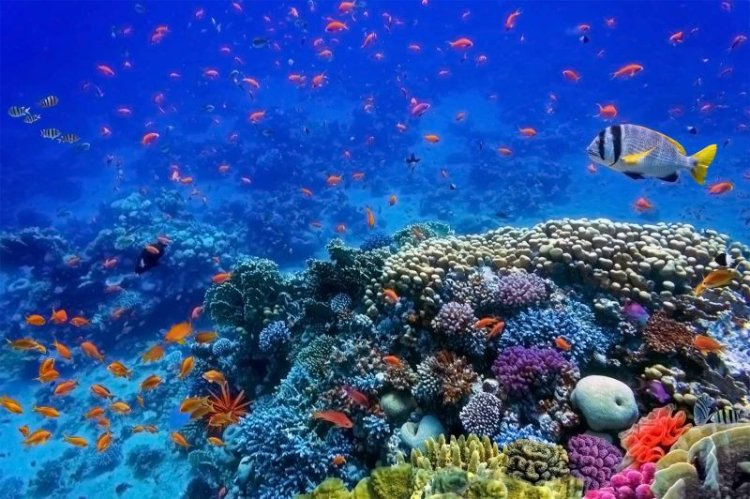Red Sea when to go
Red Sea when to go - Although some of these countries are closed to visitors due to wars and political clashes, the Egyptian Red Sea is a peaceful and conflict-free destination.

The Red Sea is located between the northeastern coast of Africa and the Arabian Peninsula and flows into Egypt, Israel, Jordan, Saudi Arabia, Yemen, Djibouti, Eritrea and Sudan. Although some of these countries are closed to visitors due to wars and political clashes, the Egyptian Red Sea is a peaceful and conflict-free destination.
When we refer to the Egyptian coast of the Red Sea, we are actually talking about two main areas: the eastern coastal part of Egypt on the African Continent and the eastern coast of the Sinai Peninsula, which is more touristy and more visited than the western coast.
Eight countries border the Red Sea, but Egypt boasts the best and most accessible resorts. Jordan and Israel have tiny slivers of coastline and both have cities that boast beaches, diving, resorts, but they don't compare to the hundreds and hundreds of kms of beautiful beaches on the Egyptian Red Sea.
On the western coast of the Red Sea, the continental one, the main seaside destinations are Ain Sokhna, Ras Gharib, El Gouna, Hurghada, Somna Bay, Safaga, Quseer and Marsa Alam.
Some of these are not destinations for foreign tourists but are considered by Egyptians as tourist destinations because they are on the coast and have some hotels and some tourist infrastructure such as restaurants and bus stops and the like. Ras Gharib, Safaga, Ain Sokhna and Quseer fit exactly into this category.
El Gouna, Hurghada, Soma Bay and Marsa Alam are 4 of the major tourist destinations along the Red Sea coast of Egypt proper.

MARSA ALAM: Once a small fishing village on the western coast of the Red Sea, Marsa Alam is today a tourist resort in rapid and continuous development thanks to the construction of an international airport.
Considered a real holiday paradise, with its palm trees and spectacular mangroves, it is the favorite destination for lovers of windsurfing, snorkelling and scuba diving: the crystal clear waters and the kilometers of coral reef are in fact populated by numerous animals and plants with spectacular colors.
The best dive spots in Marsa Alam are still relatively quiet, allowing tourists to discover underground gardens, coral reefs and numerous wrecks scattered throughout the area.
There are numerous trips organized in the surrounding area for those who wish to combine desert adventure with a beach holiday. One of the most interesting is a four-wheel drive or quad bike safari to a real Bedouin village. The tour, which can last half a day or a full day, concludes with a barbecue to the sound of Bedouin music and traditional dances.
With Supertravel, you can also book desert camel excursions! Or a desert safari at sunset or a quad bike desert safari in the morning.
Tourists of the Red Sea usually like to combine a relaxing beach holiday with a visit to the monuments of Ancient Egypt.
You can book before you leave, a day trip from Marsa Alam to Luxor, which takes around four hours.
You can also book a flight to Cairo to enjoy the treasures of Ancient Egypt ranging from the pyramids and the Sphinx to the vast collections of the Egyptian Museum.
Another interesting visit is to the ruins of the ancient emerald mining settlements in the mountainous area of the Eastern Desert southwest of Marsa Alam, in the areas of Wadi Gimal, Wadi Sikeit, Wadi Nuqrus and Gebel Zabara. These mines were extensively exploited in Roman and Ptolemaic times and constituted the most famous and active mining complex of the ancient world. This precious stone, widely used by the Pharaohs, was considered a symbol of eternity and power.
Not far from Marsa Alam are the remains of the ancient Roman port of Myos Hormos, once the main gateway to the Roman Empire in India and a port where well-preserved Roman artefacts can still be found today. In addition to these, there are around 200 4,000-year-old rock carvings in the Wadi Hammamat area, depicting traditional reed boats heading towards the Nile River.
Wadi Hammamat is also famous for the Bekhen Stone, a green rock considered sacred ever since
since ancient times, used to make cups, statues and sarcophagi, found in large numbers in the pyramids, tombs and temples.
The local handicrafts are extremely interesting, especially in the markets, which offer not only various souvenirs, but also beautifully colored handmade carpets.
Further north along the coast is Soma Bay, a coastal resort 45km from Hurghada International Airport. The autonomous community of Soma Bay is a peninsula approximately 5 km long and 2 km wide and is accessed via a private road through a single controlled entrance gate. International hotel companies have built new and luxurious resorts there.
HURGADA: A little further north of Soma Bay is Hurghada, the largest city along Egypt's Red Sea coast on the African side.
Hurghada is very popular and is the second best-selling destination in the Red Sea after Sharm el Sheikh in the Sinai peninsula.
Hurghada is accessible from Cairo both by road and by plane: it is about five hours by car from Cairo and four hours by car from Luxor, so it is possible to build itineraries without necessarily having to travel with a domestic flight.
Hurghada is the oldest holiday resort in Egypt. Offshore is the colorful and bizarre Red Sea world of coral and fish that first brought Hurghada to global attention while, on land, the former small fishing settlement has transformed into a tourist town that caters directly to western tourism.
For Europeans, this is a prime winter destination, with white sandy beaches and blue skies aplenty throughout the year.
Here too, as in Marsa Alam, in addition to relaxing on the beach, there are many activities to do which include diving on the coral reef, excursions in the desert (by quad or camel), boat trips to the Giftun Islands, or a visit to Hurghada Marina, an elegant and modern appendix to the central district of Sigala. Since it opened, it has become one of the main gastronomic destinations in the city and comes alive after dark.
THE SINAI PENINSULA: The largest and most famous resort on the Red Sea is Sharm el Sheikh.
Located on the southern tip, it is by far the most developed area on the Sinai Peninsula.
Sharm has really advanced scuba diving and water sports equipment and schools, just for the high levels of tourism.
From Sharm you can easily travel by air to Cairo, Hurgada and Luxor with very frequent flights or go to one of the other popular but smaller beach resorts along the Gulf of Aqaba on the east coast of Sinai such as Dahab or Nuweiba.
These two coastal cities are really quiet, relaxed and cheaper than the rest of Egypt. They are known for having a beachy feel without the western comforts – if that is what you are after, you will love Dahab and Nuweiba.
Sharm el-Sheikh is the main tourist center of the Sinai Peninsula and one of the best diving destinations in the world.
It was the underwater tourist attractions of the Red Sea, especially the waters of the Ras Mohammed Marine Park just south of the city, that put “Sharm” at the center of Sinai tourism and for anyone passionate about underwater life and planning a vacation.
Sharm is also one of the best destinations in Egypt if you just want to relax on the beach: even non-divers will find plenty to do as many of the Sinai Peninsula's historic and natural attractions are within a day trip from Sharm.
Finally, it is particularly appreciated for family holidays thanks to the excellent services offered.
Whether you're here for the sand or the marine life, Sharm el-Sheikh is a great choice for a beach break before or after exploring the archaeological sites and pyramids elsewhere in the country.
WHEN IS THE BEST TIME TO VISIT THE RED SEA COAST?: Egypt's Red Sea coast enjoys warm sunshine all year round. In summer the days are warm and sunny with temperatures in July ranging from 30 to 40°C. However, the sea breezes should limit the excessive heat. Spring and autumn are great times to go, with warm seas and lots of sun. Winter days are still warm but in the evening it can get cool, with night-time lows around 8°C in January.
THE CLIMATE OF EGYPT
Egypt is hot and dry most of the year, with the north having cooler weather during the winter from December to February. The winter months see pleasant temperatures ranging from around 20°C in Cairo to 26°C in Aswan.
In summer it is very hot, with temperatures ranging from 30°C on the Mediterranean coast to 50°C in Aswan and Abu Simbel.
Most of the rain falls in Alexandria while in the south it almost never rains. The average rainfall in Aswan is 10 mm in five years.
In the desert, the heat is intolerable during the day, while the nights are very cold. Much of the country is affected by the khamsin, a dry and hot wind that blows from the western desert between March and April, covering everything with a fine dust.
HIGH AND LOW SEASON IN EGYPT
The peak tourist season in Egypt is winter (December to February), when cooler temperatures make visits much more comfortable. Summer (June to August) is the low season in most of the country, except along the coasts, and prices tend to align with the influx of tourists.
Summer in Cairo is very hot and muggy, in Assan and Luxor even more, with daytime temperatures around 40°C.
However, if you crave a beach vacation, summer is the right time to head to the Red Sea or the beaches of South Sinai. Winter is the best time to visit Luxor and Aswan, although cooler temperatures also bring bigger crowds. Probably the ideal time to explore Egypt is spring (March to May) or autumn (September to November).

















